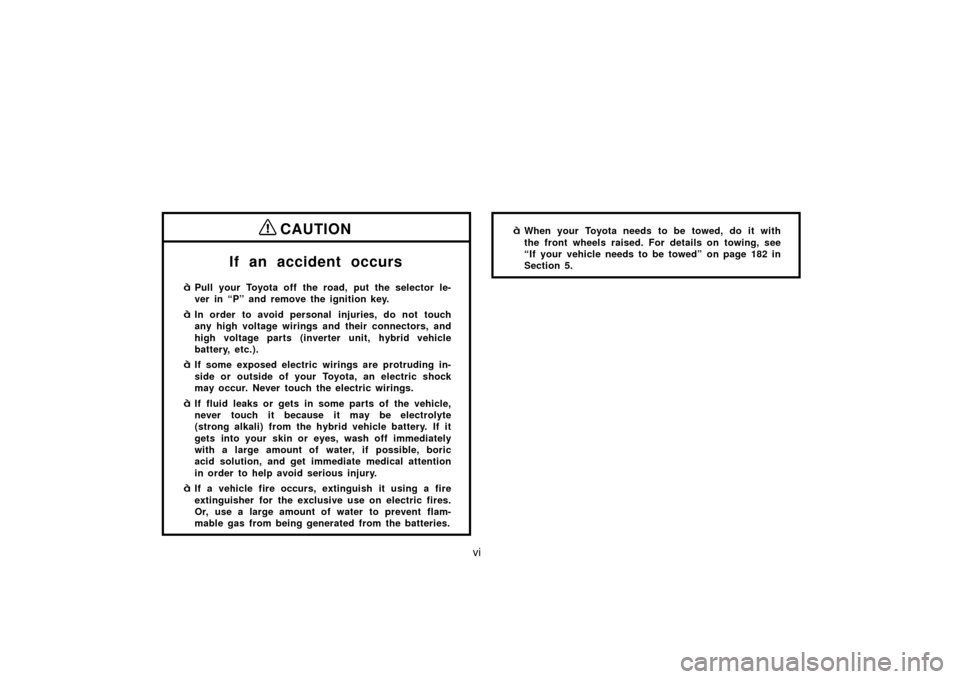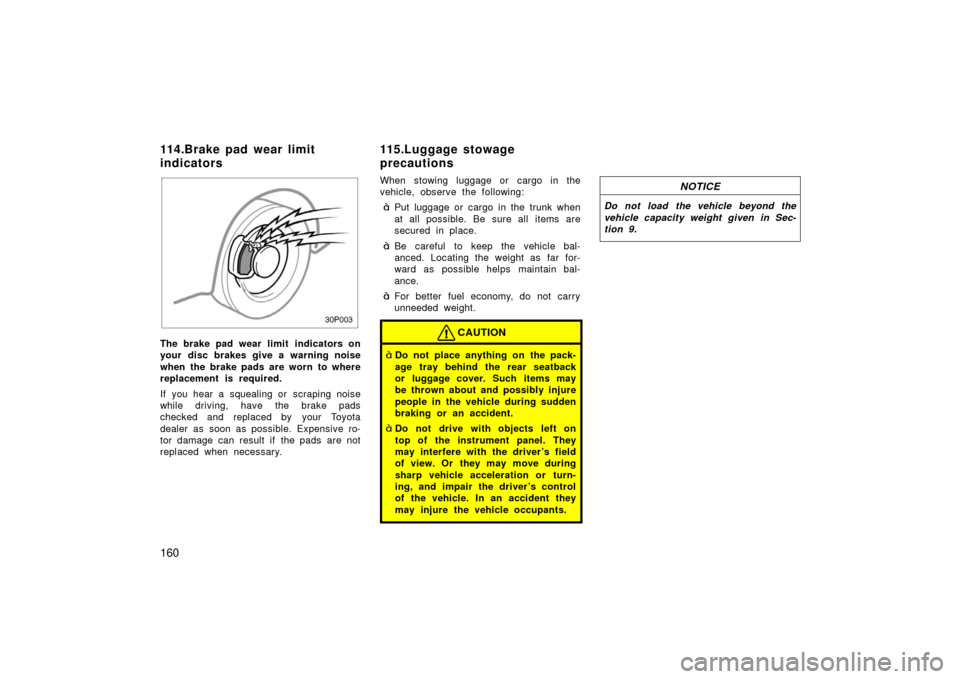Page 6 of 256

vi
CAUTION
If an accident occurs
�Pull your Toyota off the road, put the selector le-
ver in “P” and remove the ignition key.
�In order to avoid personal injuries, do not touch
any high voltage wirings and their connectors, and
high voltage parts (inverter unit, hybrid vehicle
battery, etc.).
�If some exposed electric wirings are protruding in-
side or outside of your Toyota, an electric shock
may occur. Never touch the electric wirings.
�If fluid leaks or gets in some parts of the vehicle,
never touch it because it may be electrolyte
(strong alkali) from the hybrid vehicle battery. If it
gets into your skin or eyes, wash off immediately
with a large amount of water, if possible, boric
acid solution, and get immediate medical attention
in order to help avoid serious injury.
�If a vehicle fire occurs, extinguish it using a fire
extinguisher for the exclusive use on electric fires.
Or, use a large amount of water to prevent flam-
mable gas from being generated from the batteries.
�When your Toyota needs to be towed, do it with
the front wheels raised. For details on towing, see
“If your vehicle needs to be towed” on page 182 in
Section 5.
Page 23 of 256
16
�When your vehicle needs to be
towed, do it with the front wheels
or all four wheels raised. If the
front wheels are on the ground
when towing, the electric motor
may continue to generate electricity
which could cause leakage of elec-
tricity and a fire depending on the
degree of damage. See “If your ve-
hicle needs to be towed” on page
182 in Section 5.
Page 166 of 256

160
30p003
The brake pad wear limit indicators on
your disc brakes give a warning noise
when the brake pads are worn to where
replacement is required.
If you hear a squealing or scraping noise
while driving, have the brake pads
checked and replaced by your Toyota
dealer as soon as possible. Expensive ro-
tor damage can result if the pads are not
replaced when necessary.When stowing luggage or cargo in the
vehicle, observe the following:
�Put luggage or cargo in the trunk when
at all possible. Be sure all items are
secured in place.
�Be careful to keep the vehicle bal-
anced. Locating the weight as far for-
ward as possible helps maintain bal-
ance.
�For better fuel economy, do not carry
unneeded weight.
CAUTION
�Do not place anything on the pack-
age tray behind the rear seatback
or luggage cover. Such items may
be thrown about and possibly injure
people in the vehicle during sudden
braking or an accident.
�Do not drive with objects left on
top of the instrument panel. They
may interfere with the driver’s field
of view. Or they may move during
sharp vehicle acceleration or turn-
ing, and impair the driver’s control
of the vehicle. In an accident they
may injure the vehicle occupants.
NOTICE
Do not load the vehicle beyond the
vehicle capacity weight given in Sec-
tion 9.
114.Brake pad wear limit
indicators
115.Luggage stowage
precautions
Page 171 of 256
165
120.STARTING AND DRIVING
Starting and driving
Before starting the hybrid system166
. . . . . . . . . . . . . . . . . . . . . . . . . . . . .
How to start the hybrid system 166
. . . . . . . . . . . . . . . . . . . . . . . . . . . . . . .
Tips for driving in various conditions s167
. . . . . . . . . . . . . . . . . . . . . . . . .
Winter driving tips 168
. . . . . . . . . . . . . . . . . . . . . . . . . . . . . . . . . . . . \
. . . . . .
Dinghy towing 169
. . . . . . . . . . . . . . . . . . . . . . . . . . . . . . . . . . . . \
. . . . . . . . . .
Trailer towing 169
. . . . . . . . . . . . . . . . . . . . . . . . . . . . . . . . . . . . \
. . . . . . . . . .
How to save fuel and make your vehicle last longer, too 170
. . . . . . . . .
SECTION 4
Page 175 of 256

169
Do not use your parking brake when
there is a possibility it could freeze.
When parking, put the selector lever into
“P” and block the rear wheels. Do not use
the parking brake, or snow or water accu-
mulated in and around the parking brake
mechanism may freeze, making it hard to
release.
Keep ice and snow from accumulating
under the fenders.
Ice and snow built up under your fenders
can make steering difficult. During bad
winter driving, stop and check under the
fenders occasionally.
Depending on where you are driving,
we recommend you carry some emer-
gency equipment.
Some of the things you might put in the
vehicle are tire chains, window scraper,
bag of sand or salt, flares, small shovel,
jumper cables, etc.
40p050
Your vehicle is not designed to be
dinghy towed (with four wheels on the
ground) behind a motorhome.NOTICE
Do not tow your vehicle with four
wheels on the ground. This may
cause serious damage to your ve-
hicle.
40p003a
Toyota does not recommend towing a
trailer with your Toyota. It is not de-
signed for trailer towing.
125.Dinghy towing Trailer towing126.
Page 178 of 256

172
Before making these checks, make sure
you have followed the correct starting
procedure given in ”How to start the
hybrid system” on page 166 in Section 4
and that you have sufficient fuel. Also
check whether the other keys will start the
hybrid system. If they work, your key may
be broken. Have the key checked at your
Toyota dealer. If none of your keys work,
the hybrid vehicle immobiliser system is
possibly broken. Call your Toyota dealer.
(See ”Keys” on page 18 in Section 2�1.)
If the instrument cluster dims or the
instrument cluster display turns off
with the ignition switch on—1. Check that the auxiliary battery termi- nals are tight and clean.
2. If the auxiliary battery terminals are O.K., the auxiliary battery is dis-
charged. You may try jump starting.
See “(b) Jump starting” for further in-
structions.
NOTICE
Hybrid vehicles cannot be push�
started.
If the instrument cluster is shown in
appropriate brightness with the ignition
switch turned to on—
The hybrid vehicle system is suspected to
be faulty. Contact your Toyota dealer. If the auxiliary battery is discharged,
the hybrid system can be started by
jump starting. Depending on the the ve-
hicle condition, the engine may not
start.
To avoid serious personal injury and
damage to your vehicle which might re-
sult from battery explosion, acid burns,
electrical burns, or damaged electronic
components, these instructions must be
followed precisely.
If you are unsure about how to follow this
procedure, we strongly recommend that
you seek the help of a competent qualified
technician or towing service.
If your vehicle will not start—
(a) Simple checks129.
(b) Jump starting
Page 185 of 256
179
NOTICE
Your ground clearance is reduced
when the compact spare tire is
installed so avoid driving over ob-
stacles and drive slowly on rough,
unpaved roads and speed bumps.
Also, do not attempt to go through an
automatic car wash as the vehicle
may get caught, resulting in damage.
50p008a
1. Get the required tools and sparetire.
1 Wheel nut wrench
2 Jack handle
3 Towing eyelet (For emergency towing)
4Jack
5 Spare tire
To prepare yourself for an emergency, you
should fam iliarize yourself with the use of
the jack, each of the tools and their stor-
age locations.
50p009
Turn the jack joint by hand.
To remove: Turn the joint in direction 1
until the jack is free.
To store: Turn the joint in direction 2 until
the jack is firmly secured to prevent it
flying forward during a collision or s udden
braking.
133.—Required tools and
spare tire
Page 190 of 256

184
CAUTION
�When lowering the vehicle, make
sure all portions of your body and
all other persons around will not be
injured as the vehicle is lowered to
the ground.
�Have the wheel nuts tightened by
torque wrench at 103 N·m (10.5
kgf·lbf), as soon as possible after
changing wheels. Otherwise, the
nuts may loosen and the wheels
may fall off, which could cause a
serious accident.
9. Check the air pressure of the re-placed tire.
Adjust the air pressure to the specification
designated on page 243 in Section 9. If
the pressure is lower than specified, drive
slowly to the nearest Toyota dealer and fill
to the correct pressure.
Do not forget to reinstall the tire inflation
valve cap as dirt and moisture could get
into the valve core and possibly cause air
leakage. If the cap is missing, have a new
one put on as soon as possible.
10. Restow all the tools, jack and flat tire securely.
As soon as possible after changing
wheels, tighten the wheel nuts to the
torque specified on page 243 in Section
9 with a torque wrench. Have a technician
repair the flat tire and replace the spare
tire with it.
CAUTION
Before driving, make sure all the
tools, jack and flat tire are securely
in place in their storage location to
reduce the possibility of personal in-
jury during a collision or s udden
braking.
50p021
(a) Towing with wheel lift type truck—
—From front
—From rear
(b) Using flat bed truck
—After changing wheels If your vehicle needs to be
towed—134.